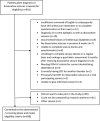Characteristics of 698 patients with dissociative seizures: A UK multicenter study
- PMID: 31608436
- PMCID: PMC6899659
- DOI: 10.1111/epi.16350
Characteristics of 698 patients with dissociative seizures: A UK multicenter study
Abstract
Objective: We aimed to characterize the demographics of adults with dissociative (nonepileptic) seizures, placing emphasis on distribution of age at onset, male:female ratio, levels of deprivation, and dissociative seizure semiology.
Methods: We collected demographic and clinical data from 698 adults with dissociative seizures recruited to the screening phase of the CODES (Cognitive Behavioural Therapy vs Standardised Medical Care for Adults With Dissociative Non-Epileptic Seizures) trial from 27 neurology/specialist epilepsy clinics in the UK. We described the cohort in terms of age, age at onset of dissociative seizures, duration of seizure disorder, level of socioeconomic deprivation, and other social and clinical demographic characteristics and their associations.
Results: In what is, to date, the largest study of adults with dissociative seizures, the overall modal age at dissociative seizure onset was 19 years; median age at onset was 28 years. Although 74% of the sample was female, importantly the male:female ratio varied with age at onset, with 77% of female but only 59% of male participants developing dissociative seizures by the age of 40 years. The frequency of self-reported previous epilepsy was 27%; nearly half of these epilepsy diagnoses were retrospectively considered erroneous by clinicians. Patients with predominantly hyperkinetic dissociative seizures had a shorter disorder duration prior to diagnosis in this study than patients with hypokinetic seizures (P < .001); dissociative seizure type was not associated with gender. Predominantly hyperkinetic seizures were most commonly seen in patients with symptom onset in their late teens. Thirty percent of the sample reported taking antiepileptic drugs; this was more common in men. More than 50% of the sample lived in areas characterized by the highest levels of deprivation, and more than two-thirds were unemployed.
Significance: Females with dissociative seizures were more common at all ages, whereas the proportion of males increased with age at onset. This disorder was associated with socioeconomic deprivation. Those with hypokinetic dissociative seizures may be at risk for delayed diagnosis and treatment.
Keywords: demographics; deprivation; dissociative (nonepileptic) seizures; onset; semiology.
© 2019 The Authors. Epilepsia published by Wiley Periodicals, Inc. on behalf of International League Against Epilepsy.
Conflict of interest statement
A.C. reports being a paid editor of the
Figures





References
-
- LaFrance WC Jr, Baker GA, Duncan R, Goldstein LH, Reuber M. Minimum requirements for the diagnosis of psychogenic nonepileptic seizures: a staged approach: a report from the International League Against Epilepsy Nonepileptic Seizures Task Force. Epilepsia. 2013;54:2005–18. - PubMed
-
- Asadi‐Pooya AA, Sperling MR. Epidemiology of psychogenic nonepileptic seizures. Epilepsy Behav. 2015;46:60–5. - PubMed
-
- Asadi‐Pooya AA, Emami M, Emami Y. Gender differences in manifestations of psychogenic non‐epileptic seizures in Iran. J Neurol Sci. 2013;332:66–8. - PubMed
-
- Behrouz R, Heriaud L, Benbadis SR. Late‐onset psychogenic nonepileptic seizures. Epilepsy Behav. 2006;8:649–50. - PubMed
-
- Duncan R, Oto M, Martin E, Pelosi A. Late onset psychogenic nonepileptic attacks. Neurology. 2006;66:1644–7. - PubMed

